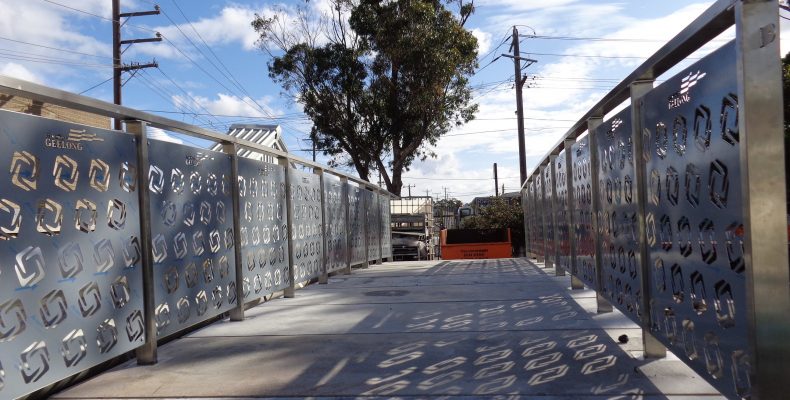Geelong’s pedestrians have only months to wait for a world-leading reinforced geopolymer bridge which is an innovative collaboration between Advanced Fibre Cluster members.
The engineering research project made global headlines when The Economist magazine featured the novel approach, adopted by Cluster member Austeng, Deakin University and the City of Greater Geelong, as well as concrete solutions company, Rocla.
Proof load testing has just been successfully completed, and the first bridge is expected to be operational in situ in the first quarter of 2021.
The bridge will look like a regular concrete pedestrian bridge but the geopolymer innovation addresses the multiple challenges of concrete cancer, embedded energy, lifecycle costs and the circular economy.
Austeng Managing Director Ross George says the project is a perfect example of cluster members uniting to combine different experiences and skillsets.
“It is also a good example of how procurement can influence technology,”
– Mr George
To encourage sustainable innovation in line with its community-led clever and creative vision, the City of Greater Geelong, with support from Cleantech Innovations Geelong, had tendered for a 100-year maintenance-free pedestrian bridge in 2017.
The tender invited companies to come up with solutions to the costly maintenance problem associated with traditional bridges – usually made of timber, steel or concrete – which cost the City around $500,000 to inspect, repair, maintain and replace each year.
Deakin University civil engineering experts Kazem Ghabraie and Mahbube Subhani completed the design of the bridges using durable carbon and glass fibre reinforced polymer.
The long-chain polymer is made by mixing fly ash, a coal industry by-product, and caustic at room temperature, emitting 80 per cent less CO2 emissions than manufacturing of conventional concrete. Cement is estimated to represent 7 per cent of the world’s CO2 emissions.
The project is proof Rocla’s geopolymer product can “confidently and reliably be designed for large structures,” Mr George says, with many possible applications such as precast walls, pipes and railway sleepers – anything which is conventionally made from concrete.
“We’re proud to say that the results show the bridge is behaving as we expected under maximum loading conditions. We’re excited that every test we have completed has given us as expected, or better than expected, results,” Mr George said.
The material is also perfect for the foundations, which sit in an acidic area on the site of an old road pitch plant yet will not deteriorate despite high sulphur levels.
“That was no issue for the reinforced geopolymer, which was perfectly suited for the application,” Mr George says.
“The bridge is finished and assembled in our carpark. We have just installed the handrails so it finally looks like a real pedestrian bridge. We are currently designing the manufacturing piers and headstocks ready for site installation.”
– Mr George
Crucially, the project solves the age-old challenge of concrete cancer in steel-reinforced concrete as the carbon fibre reinforced geopolymer beams do away with the need for traditional steel reinforcement which are subject to rust, triggering expansion, cracks and weakening, limiting the lifespan of structures.
The project was partly funded by a Federal Government grant to the Advanced Fibre Cluster Geelong.
Austeng specialises in equipment design and production, including the development of high-tech graves with a space-saving patented prefabricated system using water-resistant geopolymer concrete walls which offer up to 20 percent more efficient use of land.
The first two bridges to be replaced with the new design are timber structures over Cowies Creek in Deppler Park (“Seagull Paddock”).
Sep 2020
